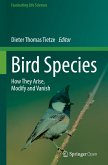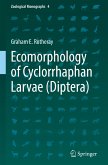Feeding in Vertebrates
Evolution, Morphology, Behavior, Biomechanics
Herausgegeben:Bels, Vincent; Whishaw, Ian Q.
Feeding in Vertebrates
Evolution, Morphology, Behavior, Biomechanics
Herausgegeben:Bels, Vincent; Whishaw, Ian Q.
- Gebundenes Buch
- Merkliste
- Auf die Merkliste
- Bewerten Bewerten
- Teilen
- Produkt teilen
- Produkterinnerung
- Produkterinnerung
This book provides students and researchers with reviews of biological questions related to the evolution of feeding by vertebrates in aquatic and terrestrial environments. Based on recent technical developments and novel conceptual approaches, the book covers functional questions on trophic behavior in nearly all vertebrate groups including jawless fishes. The book describes mechanisms and theories for understanding the relationships between feeding structure and feeding behavior. Finally, the book demonstrates the importance of adopting an integrative approach to the trophic system in order…mehr
Andere Kunden interessierten sich auch für
![Marine Mammals Marine Mammals]() Randall W. DavisMarine Mammals67,99 €
Randall W. DavisMarine Mammals67,99 €![Bird Species Bird Species]() Bird Species38,99 €
Bird Species38,99 €![The Chimpanzees of Bossou and Nimba The Chimpanzees of Bossou and Nimba]() The Chimpanzees of Bossou and Nimba149,99 €
The Chimpanzees of Bossou and Nimba149,99 €![Ecomorphology of Cyclorrhaphan Larvae (Diptera) Ecomorphology of Cyclorrhaphan Larvae (Diptera)]() Graham E. RotherayEcomorphology of Cyclorrhaphan Larvae (Diptera)112,99 €
Graham E. RotherayEcomorphology of Cyclorrhaphan Larvae (Diptera)112,99 €![Choosing Sexes Choosing Sexes]() Kristen J. NavaraChoosing Sexes58,99 €
Kristen J. NavaraChoosing Sexes58,99 €![Choosing Sexes Choosing Sexes]() Kristen J. NavaraChoosing Sexes58,99 €
Kristen J. NavaraChoosing Sexes58,99 €![Water Bears: The Biology of Tardigrades Water Bears: The Biology of Tardigrades]() Water Bears: The Biology of Tardigrades134,99 €
Water Bears: The Biology of Tardigrades134,99 €-
-
-
This book provides students and researchers with reviews of biological questions related to the evolution of feeding by vertebrates in aquatic and terrestrial environments. Based on recent technical developments and novel conceptual approaches, the book covers functional questions on trophic behavior in nearly all vertebrate groups including jawless fishes. The book describes mechanisms and theories for understanding the relationships between feeding structure and feeding behavior. Finally, the book demonstrates the importance of adopting an integrative approach to the trophic system in order to understand evolutionary mechanisms across the biodiversity of vertebrates.
Produktdetails
- Produktdetails
- Fascinating Life Sciences
- Verlag: Springer / Springer International Publishing / Springer, Berlin
- Artikelnr. des Verlages: 978-3-030-13738-0
- Seitenzahl: 865
- Erscheinungstermin: 10. Juni 2019
- Englisch
- Abmessung: 241mm x 160mm x 50mm
- Gewicht: 1520g
- ISBN-13: 9783030137380
- ISBN-10: 3030137384
- Artikelnr.: 54971173
- Herstellerkennzeichnung
- Springer-Verlag GmbH
- Tiergartenstr. 17
- 69121 Heidelberg
- ProductSafety@springernature.com
- Fascinating Life Sciences
- Verlag: Springer / Springer International Publishing / Springer, Berlin
- Artikelnr. des Verlages: 978-3-030-13738-0
- Seitenzahl: 865
- Erscheinungstermin: 10. Juni 2019
- Englisch
- Abmessung: 241mm x 160mm x 50mm
- Gewicht: 1520g
- ISBN-13: 9783030137380
- ISBN-10: 3030137384
- Artikelnr.: 54971173
- Herstellerkennzeichnung
- Springer-Verlag GmbH
- Tiergartenstr. 17
- 69121 Heidelberg
- ProductSafety@springernature.com
Vincent Bels was born in Verviers, Belgium. His Ph.D. in Ethology and Functional Morphology at the University of Liège (Liège, Belgium) integrated theoretical concepts on morphology in feeding animals. He has used lizards as a model to clarify the process of behavioral ritualization in evolution. After completing his studies, he served as a Research Fellow and then Assistant at the University of Liège (Belgium). He then taught Biology, Zoology and Ecology and developed applied research methods for studying feeding behavior in domestic animals at the Hautes Ecoles (Hainaut, Belgium) and the Associated Agronomic Centre (Belgium). He is currently a Professor at the Muséum National d'Histoire Naturelle (Paris, France), where he has served as joint director of one Research Mixed Unit (CNRS/MNHN, France). He has taught Functional Morphology at the University of Mons (Belgium). Professor Bels belongs to the Scientific Committee of the Muséum National d'Histoire Naturelle (Paris, France), and serves in Scientific Sections of the Centre National de Recherche Scientifique (CNRS, France). He has authored over 90 peer-reviewed articles, 10 book chapters, and 6 books on feeding and locomotion in vertebrates. In 1994, he edited "Biomechanics of Feeding in Vertebrates" in the series Advances in Comparative and Environmental Physiology (volume 18) published by Springer. Professor Bels' research chiefly focuses on feeding, drinking and displays in lizards, turtles and birds, but he has also studied feeding and the relation between feeding and locomotion in vertebrates. His research goal is to integrate behavioral, physiological and morphological science into a comprehensive understanding of the "Form-Function" relationship of the trophic system in vertebrates. Ian Q. Whishaw received his Ph.D. from Western University and is a Professor of Neuroscience at the University of Lethbridge. He has held visiting appointments at the University of Texas, University of Michigan, Cambridge University, and the University of Strasbourg. He is a fellow of Clair Hall, Cambridge, the Canadian Psychological Association, the American Psychological Association, and the Royal Society of Canada. He is a recipient the Canadian Humane Society Bronze medal for bravery, the Ingrid Speaker Gold medal for research, the distinguished teaching medal from the University of Lethbridge and the Donald O Hebb Prize. He has received the Key to the City of Lethbridge and has honorary doctorates from Thompson Rivers University and the University of Lethbridge. He is a coauthor of a major introductory textbook in Behavioural Neuroscience and a major senior textbook in Neuropsychology. His research addresses the neural basis of skilled movement and the neural basis of brain disease. The Institute for Scientific Information includes him in its list of most cited neuroscientists. His hobby is training horses for western performance events.
Preface.- Chapter 1. Introduction: The trophic system: a complex tool in a complex world.- Part I. Overview: from structure to behavior.- Chapter 2. Feeding, function, and phylogeny: status-of-the-art on biomechanics and form-function relationships in vertebrates.- Chapter 3. What does the mechanics of the skeleton tell us about evolution of form and function in vertebrates?.- Chapter 4. Food capture in Vertebrates: a complex integrative performance of the cranial and postcranial systems.- Chapter 5. Transitions from water to land: terrestrial feeding in fishes.- Chapter 6. The evolution of the hand as a tool in feeding behavior: the multiple motor channel theory of reaching.- Part II. Anatomy, Biomechanics and Behavior in chordate and vertebrate lineages.- Chapter 7. Feeding in jawless fishes.- Chapter 8. Feeding in cartilaginous fishes: An interdisciplinary synthesis.- Chapter 9. Functional Morphology and Biomechanics of Feeding in Fishes.- Chapter 10. Evolutionary specialization of the tongue in vertebrates: structure and function.- Chapter 11. Tetrapod Teeth: Diversity, Evolution, and Function.- Chapter 12. Feeding in amphibians: evolutionary transformations and phenotypic diversity as drivers of feeding system diversity.- Chapter 13. Feeding in lizards: form -function and complex multifunctional system.- Chapter 14. Feeding in snakes: form, function, and evolution of the feeding system.- Chapter 15. Feeding in crocodylians and their relatives: functional insights from ontogeny and evolution.- Chapter 16. Feeding in turtles: understanding terrestrial and aquatic feeding in a diverse but monophyletic group.- Chapter 17. Feeding in Birds: Thriving in Terrestrial, Aquatic, and Aerial Niches.- Chapter 18. F Feeding in mammals: comparative, experimental and evolutionary insights on form and function.- Chapter 19. Feeding in Aquatic Mammals: An Evolutionary and Functional Approach.- Chapter 20. Evolution, constraint and optimality in primate feeding systems.- Chapter 21. The Masticatory Apparatus of Humans (Homo sapiens): Evolution and Comparative Functional Morphology.
Preface.- Chapter 1. Introduction: The trophic system: a complex tool in a complex world.- Part I. Overview: from structure to behavior.- Chapter 2. Feeding, function, and phylogeny: status-of-the-art on biomechanics and form-function relationships in vertebrates.- Chapter 3. What does the mechanics of the skeleton tell us about evolution of form and function in vertebrates?.- Chapter 4. Food capture in Vertebrates: a complex integrative performance of the cranial and postcranial systems.- Chapter 5. Transitions from water to land: terrestrial feeding in fishes.- Chapter 6. The evolution of the hand as a tool in feeding behavior: the multiple motor channel theory of reaching.- Part II. Anatomy, Biomechanics and Behavior in chordate and vertebrate lineages.- Chapter 7. Feeding in jawless fishes.- Chapter 8. Feeding in cartilaginous fishes: An interdisciplinary synthesis.- Chapter 9. Functional Morphology and Biomechanics of Feeding in Fishes.- Chapter 10. Evolutionary specialization of the tongue in vertebrates: structure and function.- Chapter 11. Tetrapod Teeth: Diversity, Evolution, and Function.- Chapter 12. Feeding in amphibians: evolutionary transformations and phenotypic diversity as drivers of feeding system diversity.- Chapter 13. Feeding in lizards: form -function and complex multifunctional system.- Chapter 14. Feeding in snakes: form, function, and evolution of the feeding system.- Chapter 15. Feeding in crocodylians and their relatives: functional insights from ontogeny and evolution.- Chapter 16. Feeding in turtles: understanding terrestrial and aquatic feeding in a diverse but monophyletic group.- Chapter 17. Feeding in Birds: Thriving in Terrestrial, Aquatic, and Aerial Niches.- Chapter 18. F Feeding in mammals: comparative, experimental and evolutionary insights on form and function.- Chapter 19. Feeding in Aquatic Mammals: An Evolutionary and Functional Approach.- Chapter 20. Evolution, constraint and optimality in primate feeding systems.- Chapter 21. The Masticatory Apparatus of Humans (Homo sapiens): Evolution and Comparative Functional Morphology.








